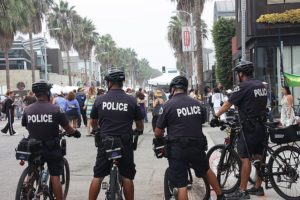
Late last night the plaintiffs filed a searing opposition to last month’s defendants motion to dismiss. Part of the plaintiffs’ argument relies on the fact that the Boardwalk is actually a public sidewalk, and in support of that argument they also filed a request for judicial notice that included a certified copy of the deed by means of which Abbott Kinney gave the boardwalk to the City (of Ocean Park; Los Angeles didn’t get it until 1926). To understand the issues it may be useful to look at the text of LAMC §42.15.
The issue is whether or not the Boardwalk is a public forum. If it is, the First Amendment places a very, very high barrier before the City’s attempt to regulate speech there at all. Sidewalks, as opposed to City-sponsored Disneylandesque bullshit tourist-trap money magnets, are quintessential public forums,1 and this is the heart of the argument:2
The Venice Boardwalk is a traditional public forum long recognized by the City as perhaps the most prominent free speech area in the City. Although called a “boardwalk,” this pedestrian passageway is a public sidewalk, deeded to the City as a sidewalk in perpetuity in 1906. See Plaintiffs’ Request for Judicial Notice and Exhibit 1.
Public sidewalks “occupy a ‘special position in terms of First Amendment protection’ because of their historic role as sites for discussion and debate[.]” They are the locations where people encounter speech they “might otherwise tune out.” “From time immemorial,” public sidewalks have been locations where “normal conversation and leafleting” have occurred as part of the First Amendment’s guarantee of “sharing ideas.” Indeed, public sidewalks are, perhaps, the most important traditional public forum because of their availability at any time at no cost.
It’s worth reading the whole response, and some selections that caught my eye appear after the break.
Plaintiffs challenge the application of LAMC §42.15 to their core speech activities in an archetypal public forum, the Venice Boardwalk. 1 Plaintiffs are long-time community activists in the Venice section of the City of Los Angeles. Among the issues on which they advocate are police misconduct and homelessness, two matters at the center of the City’s current political debate. Complaint at ¶7. Last year, two homeless men were killed by the Los Angeles Police Department in Venice. One, Brendan Glenn, was shot in the back on the Boardwalk in what LAPD Chief Beck has described as a criminal act.
Plaintiffs want to reach the local Venice community to enlist support on these subjects of overriding public concern. Comp. at ¶8, 27. On two occasions, when she sought to reach local residents in the historic Venice public forum, LAPD officers threatened Kennedy with citations if she did not stop what they told her was unlawful activity under LAMC §42.15: tabling and seeking donations. No officer told Plaintiff that she could table after sunset if she moved to an “undesignated” space, or that she could “solicit” at some other place on the Boardwalk.
And in response to the City’s contention that setting up a table to hand out leaflets and hold discussions is forbidden, but walking on the Boardwalk while doing the same things is permitted we have:
As discussed below, none of these asserted governmental interests are implicated by Plaintiffs’ activities and none have been held sufficient to justify a time, place or manner regulation restricting access to a traditional public forum for core speech activity, including solicitation. For example, in Foti, the Ninth Circuit held that an ordinance requiring persons carrying signs on a sidewalk to move continually was unconstitutional because it was not narrowly tailored to serve the state’s interest in the free flow of pedestrian traffic on sidewalks. “Requiring picketers to shuffle back and forth does not contribute to safe and convenient circulation on sidewalks; presumably, pedestrians could better negotiate around a stationary picketer than one who is walking back and forth.”
The result would be no different here. Plaintiffs want to stand off to the west side of the Boardwalk, allowing passersby to come to them, look at their flyers and petitions, and engage in discussion on issues of primary concern throughout the City. The LAPD has informed Plaintiffs that they must be in the middle of the Boardwalk, constantly moving, to engage in their petitioning activities. There is not, nor can there be, any showing that allowing Plaintiffs to engage in this activity with a small folding table in a “Designated Space” after sunset so impedes Defendants’ interests that it must be severely restricted, if not banned in practical effect, after sunset.
Anyway, like I said, it’s worth reading the whole response.
Image of LAPD on the beach is freely licensed and I got it from Wikimedia.
- The public forum doctrine accounts, e.g., for the presence of Kerry Morrison’s bête noire, the street characters in front of Hollywood and Highland. If the City can’t get rid of freaking Spiderman on Hollywood Boulevard, where the forces of evil are so much more entrenched than ever they will be on the Boardwalk, how, I wonder, do they think they’re going to get rid of pampleteers on the Boardwalk?
- I removed citations to authorities. If you need to see those check the original document
